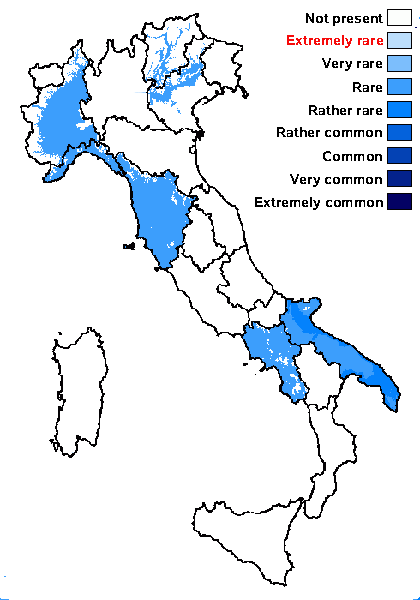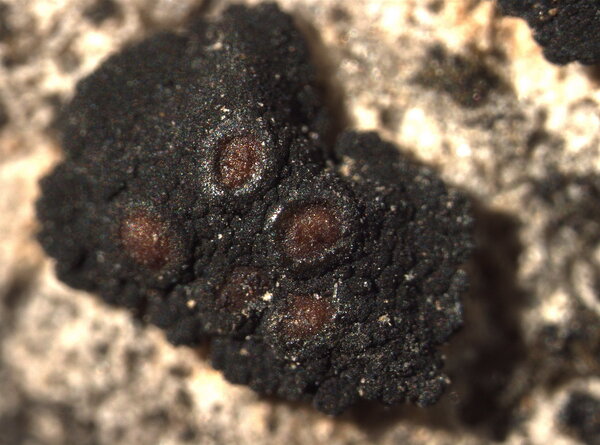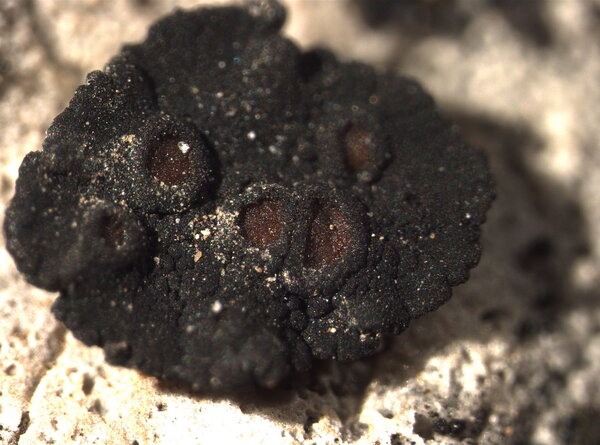Anema nummularium var. notarisii (A. Massal.) Zanfr.
Atti Soc. natural. mat. Modena, ser. 4, 8: 32, 1906.. Basionym: Omphalaria notarisii A. Massal. - Framm. Lichenogr.: 13, 1855.
Synonyms: Anema nummulariellum Nyl.
Distribution: N - Ven, TAA, Piem, Lig. C- Tosc. S - Camp, Pugl.
Description: Thallus squamulose-umbilicate, homoiomerous, slightly gelatinous when wet, 0.2-0.4 mm thick, in section with a loosely reticulate network of thin hyphae enclosing groups of cyanobacterial cells. Squamules black, epruinose, dispersed to crowded, closely attached, 3-6 mm wide, button-like, epruinose, not isidiate, attached by a central, compact bundle of rhizohyphae, with an indistinctly lobulate margin, the lobules short, contiguous, smooth, slightly convex, rounded at apex. Apothecia pycnoascocarps, 2-3 per squamule, at first immersed and urceolate but soon expanded and clearly lecanorine, 0.3-1(-1.5) mm across, with a dark reddish brown, concave to flat disc, and a thick, usually smooth thalline margin. Proper exciple poorly developed; epithecium brownish orange; hymenium colourless, the hymenial gel I+ blue, paraphyses moniliform, the upper cell clearly swollen; hypothecium yellowish. Asci 8-spored, cylindrical-clavate, thin-walled, with an amyloid external apical cap. Ascospores 1-celled, hyaline broadly ellipsoid to ellipsoid, 7-15 x 4-10(-12) µm, the wall 1-2 µm thick. Pycnidia immersed, globose, unilocular. Conidia hyaline, ellipsoid, 3-4 x 0.5-1.5 µm. Photobiont cyanobacterial, chroococcoid, of a few 8-13 µm wide cells often penetrated by haustoria and surrounded by a gelatinous sheath which is colourless in inner parts, yellowish brown near the thallus surface. Spot tests: all negative. Chemistry: without lichen substances.Note: on steeply inclined surfaces of limestone and dolomite with periodical water seepage after rain, below the montane belt. It was considered by Henssen & Jorgensen (1990) as a good species, but according to Moreno & Egea (1992) a study of some populations showed that it is just part of the variation of A. nummularium.
Growth form: Squamulose
Substrata: rocks
Photobiont: cyanobacteria, coccaceous (e.g. Gloeocapsa)
Reproductive strategy: mainly sexual
On otherwise dry surfaces with short periods of water seepage after rain
Commonnes-rarity: (info)
Alpine belt: absent
Subalpine belt: absent
Oromediterranean belt: absent
Montane belt: absent
Submediterranean belt: rare
Padanian area: absent
Humid submediterranean belt: rare
Humid mediterranean belt: rare
Dry mediterranean belt: rather rare

Predictive model
Growth form: Squamulose
Substrata: rocks
Photobiont: cyanobacteria, coccaceous (e.g. Gloeocapsa)
Reproductive strategy: mainly sexual
On otherwise dry surfaces with short periods of water seepage after rain
Commonnes-rarity: (info)
Alpine belt: absent
Subalpine belt: absent
Oromediterranean belt: absent
Montane belt: absent
Submediterranean belt: rare
Padanian area: absent
Humid submediterranean belt: rare
Humid mediterranean belt: rare
Dry mediterranean belt: rather rare

Predictive model





